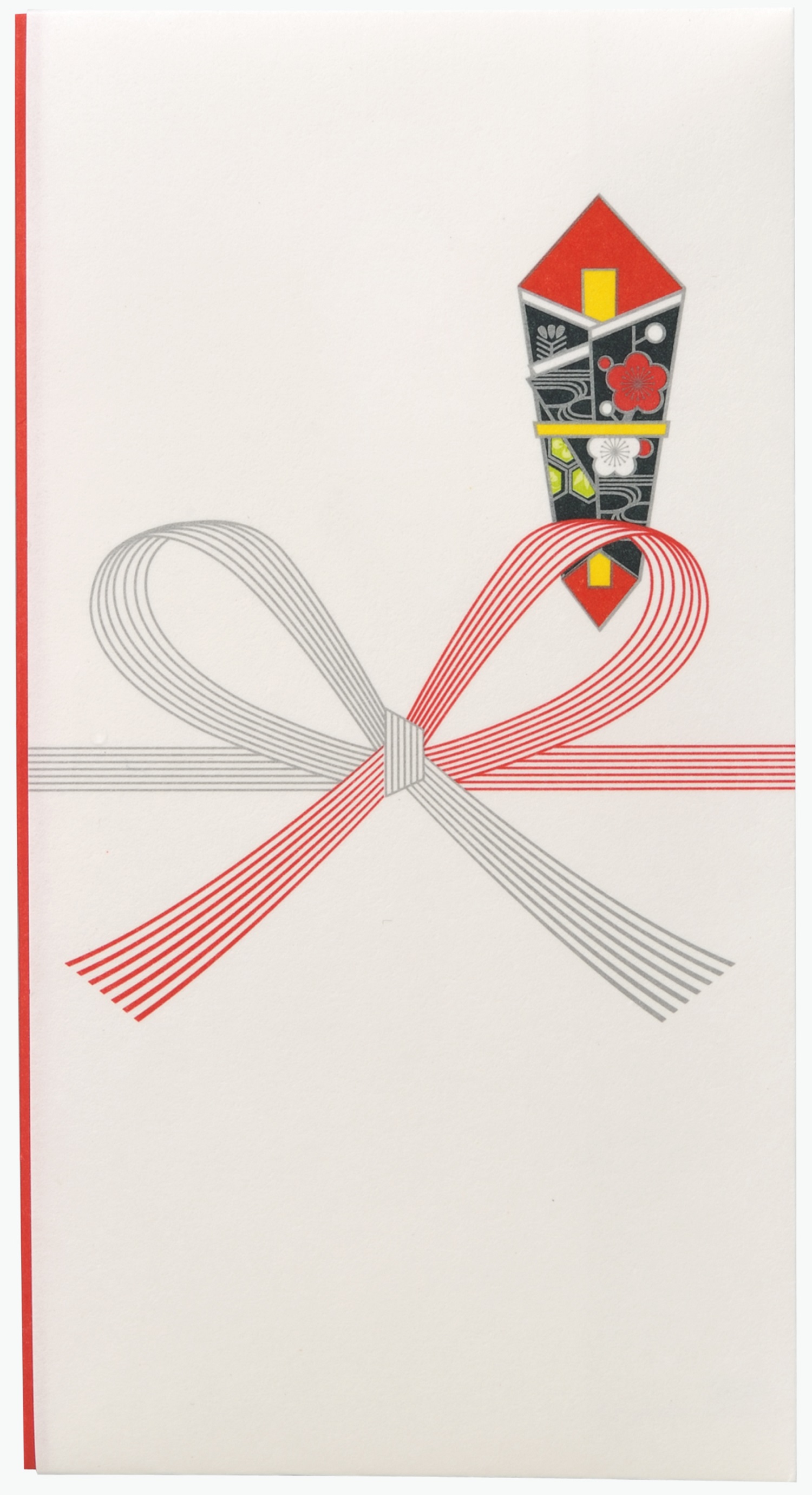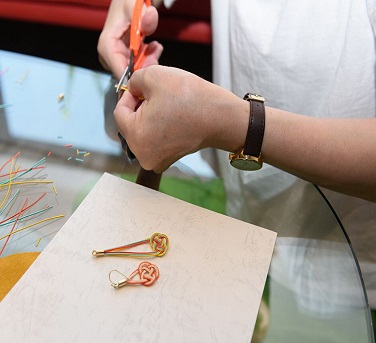Japanese Paper Cord Mizuhiki Designs How to Make Bracelet

Red and white Mizuhiki, wrapped around a gift. Easy to unwind, the Mizuhiki bow is used for something that may be repeated "time and time again" such as baby gifts etc.
In Japan both Mizuhiki and Noshi are essential when formally exchanging gifts. Mizuhiki is a decorative cord used for tying the paper that is wrapped around gifts. There is a difference in the significance of the "wrapping paper and ribbon" used in the West and Japan's "Mizuhiki". Recently, the use of Mizuhiki has spread beyond its original purpose for gifts and it is used to decorate trinkets and accessories etc.
Noshi is a decoration that is attached to celebratory gifts. It is a time-honored custom to add a thinly stretched piece of dried abalone to gifts as a wish for good luck; abalone being a valuable marine product that is supposed to bring longevity. This has gradually been simplified so that today we usually use Noshi that is wrapped around a strip of yellow paper resembling abalone or, to take it one step further, paper that is printed with Noshi and Mizuhiki.

Paper folded into an envelope is used to present monetary gifts at wedding ceremonies and similar occasions. In the upper right corner of each envelope is the Noshi. In accordance with ancient tradition, the Noshi on the left envelope uses genuine abalone and the finest quality Washi (fibrous Japanese paper). While the envelope on the right uses a strip of yellow paper in imitation of the abalone (Kyukyodo)
An Established Manner of Life
While many aspects of the origins of Mizuhiki remain a mystery, we know that since before the 9th century at least, red and white hemp cord was wrapped around offerings made to the highest authorities of the time, and that in the period from the 9th-12th centuries paper cord dyed in the original Mizuhiki colors of red and white or gold and silver started to be used instead of hemp cord. In due course the custom of placing a white sheet of paperon a gift, binding it with Mizuhiki and attaching Noshi spread to the common people. It is said to have become a formal manner of everyday life during the 17th-19th centuries and havebeen firmly established in Japanese culture.
Expressing the Feelings of the Gift-Giver
While it may just look like Japanese-style gift-wrap packaging, there is a significant difference between Japanese Mizuhiki and Western-style wrapping and ribbons whose focus is the opening of the parcel. There are various manners of making Mizuhiki depending on the setting and purpose for which it is to be used.
Generally it is made by twisting thin lengths of Washi (a traditional, fibrous Japanese paper that is very durable) and hardening them with glue. There are many color combinations such as gold & silver, red & white, black & white, or yellow & white, with the number of strands, color and style of tying the Mizuhiki being determined according to the purpose of the gift. In short, just by looking at the gift we can appreciate not just the article itself, but also the delicate care taken by the giver.

"Mizuhiki" thin lengths of twisted Washi hardened with glue.
Typically, the number of Mizuhiki strands used differed depending on whether the occasion was a celebration such a marriage or the birth of a child, or a commemoration such as a funeral. In Japan, it is the custom to give cash at celebrations and commemorations, which is wrapped in paper with a Noshi attached and then tied with Mizuhiki. Odd numbers are thought to be auspicious, so combinations of odd numbers of Mizuhiki such as 3, 5, or 7 strands were used for celebrations, and even numbers were used for commemorations. However, these days sets of 5 strands have become commonplace for both celebrations and commemorations. For weddings only, sets of 10 strands are often used - as 10 is the double of 5 and is therefore thought to be doubly auspicious.
In terms of color, "red & white" or "gold & silver are used for celebrations, while "black & white" or "yellow & white" are used for commemorations.
The most characteristic feature of Mizuhiki is the way they are tied. Broadly speaking, the style of tying Mizuhiki can be divided into "musubi-kiri" (a style of fixed decorative fastening) and "chou-musubi" (a butterfly knot); with different styles indicating a belief in superstitious omens. The musubi-kiri incorporates the idea that "something should never be repeated a second time" and that one tie of the knot will produce a bind that never unravels. As a result, musubi-kiri is used not only for celebrations such as marriage, but also generally for occasions that we hope will only happen once - such as in get-well wishes and condolences. On the other hand, chou-musubi can be undone and unwound with the pull of a string, and this style of Mizuhiki is used for celebrations such as childbirth or admission to college etc; the idea being that the occasion "is a joyful one, no matter how many times it occurs" and that "it may be repeated time and time again". Even when Mizuhiki are tied in the same way, the use of different colors can reflect the purpose of the gift.

Gold and silver Mizuhiki are used for celebrations such as wedding ceremonies etc., and are tied with inextricable knots (Kyukyodo)

Mainly used in "Hoji" (a Buddhist memorial service) - a ceremony to commemorate the deceased. Cash is inserted and handed to the bereaved family as a mark of condolence. Black and white Mizuhiki tied in a musubi-kiri style (Kyukyodo)

These days traditional methods have been simplified and we also use envelopes with Noshi and Mizuhiki printed on them
Contemporary Developments
Originally Mizuhiki were used in the sense of a seal or an amulet, indicating unopened status; however with the changing times, they have increasingly come to signify ties between people. Mizuhiki are often used in the form of an inextricable knot - the harder you pull, the more firmly the knot is tied. Included in the tying style is the hope to have a relationship that will prove difficult to separate. The sets of 5 strands used are also said to represent a person's hand, with the tying of the strands indicating a handshake.

A wide range of envelopes for wedding gifts, with sumptuous Noshi and Mizuhiki (Ito-ya)

Example of use. An envelope containing cash is handed over as a present

The inside is opened out. The envelope is not glued down. Money is placed in the white envelope, which is wrapped in the surrounding paper and fastened on top with a ring-shaped Mizuhiki
Mizuhiki are enjoying fresh developments. Recently they are being used for accessories and small interior design items and are proving particularly popular as souvenirs for overseas tourists. Accordingly, there is increasing variation in the colors of the Mizuhiki themselves, including primary colors, pastels, metallics, and single strands of multiple colors etc. Books are published on how to make accessories using Mizuhiki and workshops are held all over the place. It seems that in future more and more possibilities will open up for Mizuhiki.



Hands-on workshop where accessories are made using Mizuhiki; and the finished earrings (kou-bou-en)

Pouch knitted with Mizuhiki (kou-bou-en)

Hair grips with Mizuhiki (kou-bou-en)

Miniature wreaths made with Mizuhiki (kou-bou-en)

Trinkets made with Mizuhiki are popular as souvenirs for overseas tourists (Ito-ya)

Mizuhiki are also used in gift wrapping. Some shops will even make them on the spot in your favorite color and style of knot (Ito-ya)
Japanese Paper Cord Mizuhiki Designs How to Make Bracelet
Source: https://web-japan.org/trends/11_fashion/fas180104.html
0 Response to "Japanese Paper Cord Mizuhiki Designs How to Make Bracelet"
Post a Comment